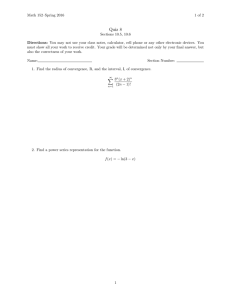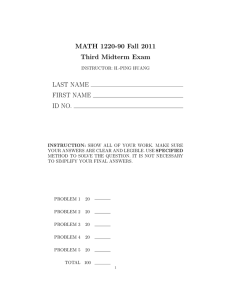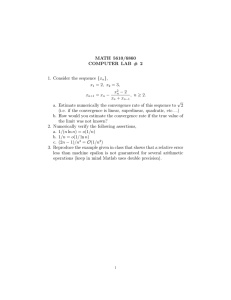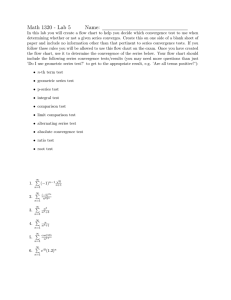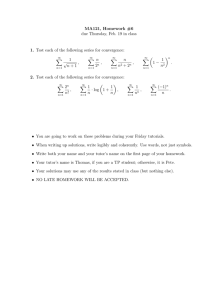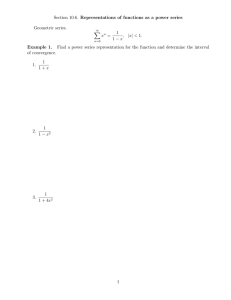A Fast Algorithm for Solving Nonlinear Equations Xiaodong Wang , Lei Wang
advertisement
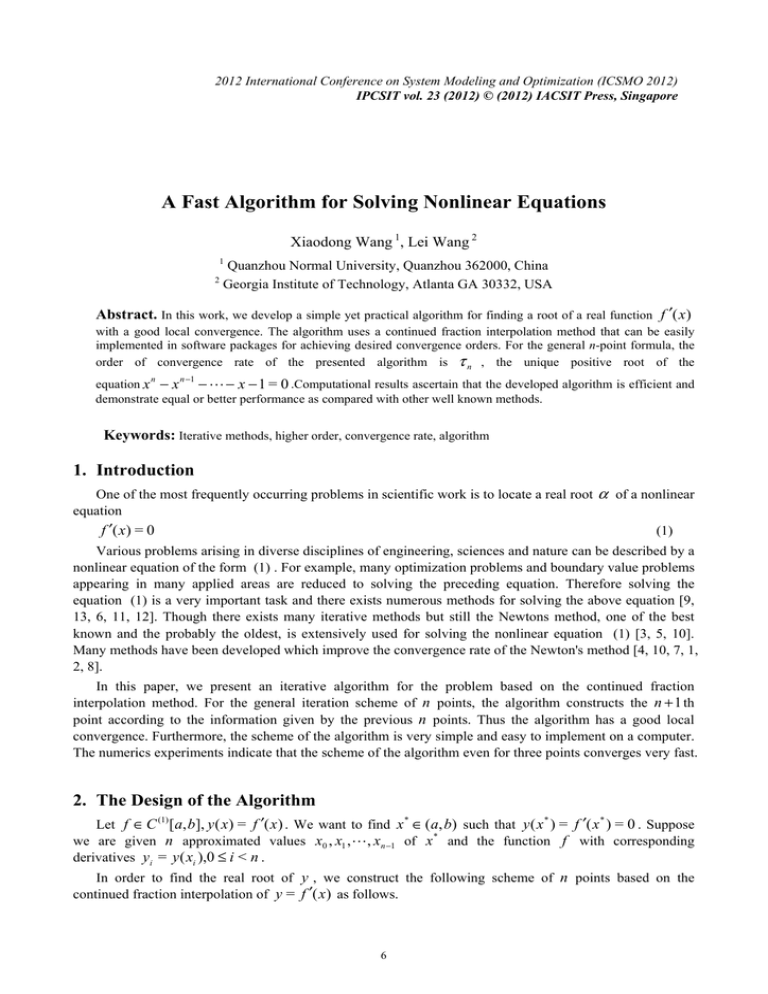
2012 International Conference on System Modeling and Optimization (ICSMO 2012)
IPCSIT vol. 23 (2012) © (2012) IACSIT Press, Singapore
A Fast Algorithm for Solving Nonlinear Equations
Xiaodong Wang 1, Lei Wang 2
1
2
Quanzhou Normal University, Quanzhou 362000, China
Georgia Institute of Technology, Atlanta GA 30332, USA
Abstract. In this work, we develop a simple yet practical algorithm for finding a root of a real function f ′(x)
with a good local convergence. The algorithm uses a continued fraction interpolation method that can be easily
implemented in software packages for achieving desired convergence orders. For the general n-point formula, the
order of convergence rate of the presented algorithm is τ n , the unique positive root of the
n −1
equation x − x − " − x − 1 = 0 .Computational results ascertain that the developed algorithm is efficient and
demonstrate equal or better performance as compared with other well known methods.
n
Keywords: Iterative methods, higher order, convergence rate, algorithm
1. Introduction
One of the most frequently occurring problems in scientific work is to locate a real root α of a nonlinear
equation
f ′(x) = 0
(1)
Various problems arising in diverse disciplines of engineering, sciences and nature can be described by a
nonlinear equation of the form (1) . For example, many optimization problems and boundary value problems
appearing in many applied areas are reduced to solving the preceding equation. Therefore solving the
equation (1) is a very important task and there exists numerous methods for solving the above equation [9,
13, 6, 11, 12]. Though there exists many iterative methods but still the Newtons method, one of the best
known and the probably the oldest, is extensively used for solving the nonlinear equation (1) [3, 5, 10].
Many methods have been developed which improve the convergence rate of the Newton's method [4, 10, 7, 1,
2, 8].
In this paper, we present an iterative algorithm for the problem based on the continued fraction
interpolation method. For the general iteration scheme of n points, the algorithm constructs the n + 1 th
point according to the information given by the previous n points. Thus the algorithm has a good local
convergence. Furthermore, the scheme of the algorithm is very simple and easy to implement on a computer.
The numerics experiments indicate that the scheme of the algorithm even for three points converges very fast.
2. The Design of the Algorithm
Let f ∈ C (1) [a, b], y ( x) = f ′( x) . We want to find x * ∈ (a, b) such that y ( x * ) = f ′( x * ) = 0 . Suppose
we are given n approximated values x0 , x1 ,", xn −1 of x * and the function f with corresponding
derivatives yi = y ( xi ),0 ≤ i < n .
In order to find the real root of y , we construct the following scheme of n points based on the
continued fraction interpolation of y = f ′( x) as follows.
6
ψ ( y ) = a0 +
(2)
y − yn −1
y − yn − 2
a1 +
y − y2
%
y − y1
an − 2 +
an −1
The k th order difference of function f can be defined recursively as follows.
⎧Φ 0 ( y ) = x
⎪⎪
y − yk
, k = 1,2, "
⎨Φ k ( y1 , " , y k , y ) =
Φ
(
y
,
"
,
y
k −1
1
k −1 , y ) − Φ k −1 ( y1 , " , y k )
⎪
⎩⎪
(3)
It follows from the inverse interpolation condition ψ ( yi ) = xi ,0 ≤ i < n that
⎧a0 = xn −1 = Φ 0 ( y n −1 )
⎪
⎨ai = Φ i ( y n −1 ," , y n −i −1 ), i = 1,2, ", n − 1
⎪
⎩
(4)
It follows that
ψ (0) = a0 −
a1 −
%
y n −1
yn−2
y2
an − 2 −
(5)
y1
an −1
According to the formula described above, we can design a very simple iteration algorithm to find x * as
follows.
Algorithm 2.1: Inverse-Interpolation(f)
Input x0 , x1 ,", xn −1 , ε
for i ← 0 to n − 1
do yi ← f ′( xi )
while yn −1 > ε
⎧ g ( y n−1 , " , y1 )
⎪
y n−1
⎪ x n ← a0 −
y n−2
⎪
a1 −
y2
⎪
%
do ⎨
y
an−2 − 1
⎪
an−1
⎪
⎪ y n ← f ' ( xn )
⎪
⎩n ← n + 1
Output ( xn , yn , f ( xn ))
where the function g ( y n −1 ,", y1 ) is used to compute the coefficients a0 ,", an −1 according to the
formula (4) .
3. The Convergence of the Algorithm
7
.
If
for
,
the
limit
f ∈ C (1) [a, b], x ∈ [a, b]
xi ∈ [a, b],0 ≤ i ≤ k
′
′
f
exists,
then
the
function
is
th
inverse
differentiable
and
Φ
(
f
(
x
),
"
,
f
(
x
))
=
Φ
(
x
)
k
lim
k
0
k
k
Suppose
x0 ,", xk → x
Φ k ( x) is called the k th inverse derivative of f at x .
Let x * ∈ [a, b] and f ′( x * ) = 0 . The function type T ( n ) [a, b] ⊆ C (1) [a, b] can be defined as
(6)
T ( n ) [a, b] = { f | f kth inverse differentiable in [a, b], Φ k ( x* ) ≠ 0,1 ≤ k ≤ n}
Suppose for any function f ∈ T ( n ) [a, b] , the point sequence generated by algorithm 2.1 be {xk }1∞ . From
the computing steps of the algorithm we know xk +1 can be formulated as
xk +1 = a0 −
yk
y k −1
a1 −
yk − n +3
%
y
an − 2 − k − n + 2
an −1
where a0 = xk = Φ 0 ( y k ) , and ai = Φ i ( y k , ", y k −i ), i = 1,2, ", n − 1 .
Now, we can compte ψ 1 ( y ) , the n + 1 points inverse continued fraction interpolation of y = f ′( x) at
x , xk − n +1 ,", xk as follows
*
ψ 1 ( y ) = a'0 +
y − yk
y − yk −1
a'1 +
y − yk −n+3
%
y − yk − n + 2
a 'n − 2 +
y − yk −n+1
a 'n−1 +
a 'n
(7)
It follows from the inverse interpolation condition ψ 1 ( yi ) = xi , k − n + 1 ≤ i ≤ k , and ψ 1 (0) = x* that
a'i = ai ,0 ≤ i < n , and a'n = Φ n ( yk ,", yk −n+1 ,0) .
It follows that
ψ 1 (0) = a0 −
yk
= x*
y k −1
a1 −
yk −n+ 2
%
y
an −1 − k − n +1
an '
Denote x * =
(8)
Pn
P
, and xk +1 = n −1 . It is not difficult to see that
Qn
Qn −1
n
yk − n + i
∏
Pn −1 Pn
i =1
−
| xk +1 − x |=
=
Qn −1 Qn
| Qn −1Qn |
*
It follows that
n
n
| xk +1 − x |= ∏ | xk − n + i − x |
*
i =1
*
∏Φ ( y
1
k − n +i
,0)
i =1
(9)
Qn −1Qn
8
f ∈ T n [a, b] . There must be ε > 0 and δ 1 > 0 such that when
{xk − n +1 ,", xk } ⊂ o( x * , δ 1 ) , | Qn −1Qn |≥ ε .
Theorem 2 Let f ∈ T n [a, b] . There must be δ > 0 such that when {x0 , ", xn −1} ⊂ o( x * , δ ) , the
sequence {xk }1∞ generated by the algorithm 2.1 converges to x * .
Theorem
1
Let
4. References
[1] S. Amat, C. Bermudez, S. Busquier, D. Mestiri, A family of Halleys Chebyshev iterative schemes for non-Frchet
differentiable operators, J. Comput. Appl. Math. , 216, 486-493, 2009.
[2] S. Amat, S. Busquier, J.M. Gutierrez, Geometric constructions of iterative functions to solve nonlinear equations,
J. Comput. Appl. Math. , 157, 197-205, 2003.
[3] I. K. Argyros, Computational theory of iterative methods, Studies in Computational Mathematics , ed. Chui, C.K.,
Wuytack, L., Elsevier, New York, 2007.
[4] W. Bi, H. Ren, Q. Wu, Three-step iterative methods with eighth-order convergence for solving nonlinear
equations, J. Comput. Appl. Math. , 225, 105-112, 2009.
[5]
C. Chun, Y. Ham, Some sixth-order variants of Ostrowski root-finding methods, Appl. Math. Comput. , 193,
389-394, 2003.
[6]
C. Chun, Construction of Newton-like iteration methods for solving nonlineare quations, Numer. Math. , 104,
297-315, 2006.
[7]
V. Kanwar, S.K. Tomar, Modified families of Newton, Halley and Chebyshev methods, Appl. Math. Comput. ,
192, 20-26, 2007.
[8]
J. Kou, Some variants of Cauchy's method with acceleratedfourth-order convergence, J. Comput. Appl. Math. ,
213, 71-78, 2008.
[9]
B. Neta, On a family of multipoint methods for non-linear equations, Int. J. Comput. Math. , 9, 353-361, 1981.
[10] N. Osada, Chebyshev-Halley methods for analytic functions, J. Comput. Appl. Math. , 216, 585-599, 2008.
[11] H. Ren, Q. Wu, W. Bi, New variants of Jarratts method with sixth-order convergence, Numer. Algorithms , 52,
585-603, 2009.
[12] J.R. Sharma, R.K. Guha, A family of modified Ostrowski methods with accelerated sixth order convergence,
Appl. Math. Comput. , 190, 111-115, 2007.
[13] J.F. Traub, Iterative Methods for the Solution of Equations, Chelsea Publishing Company, New York, 1977.
9

